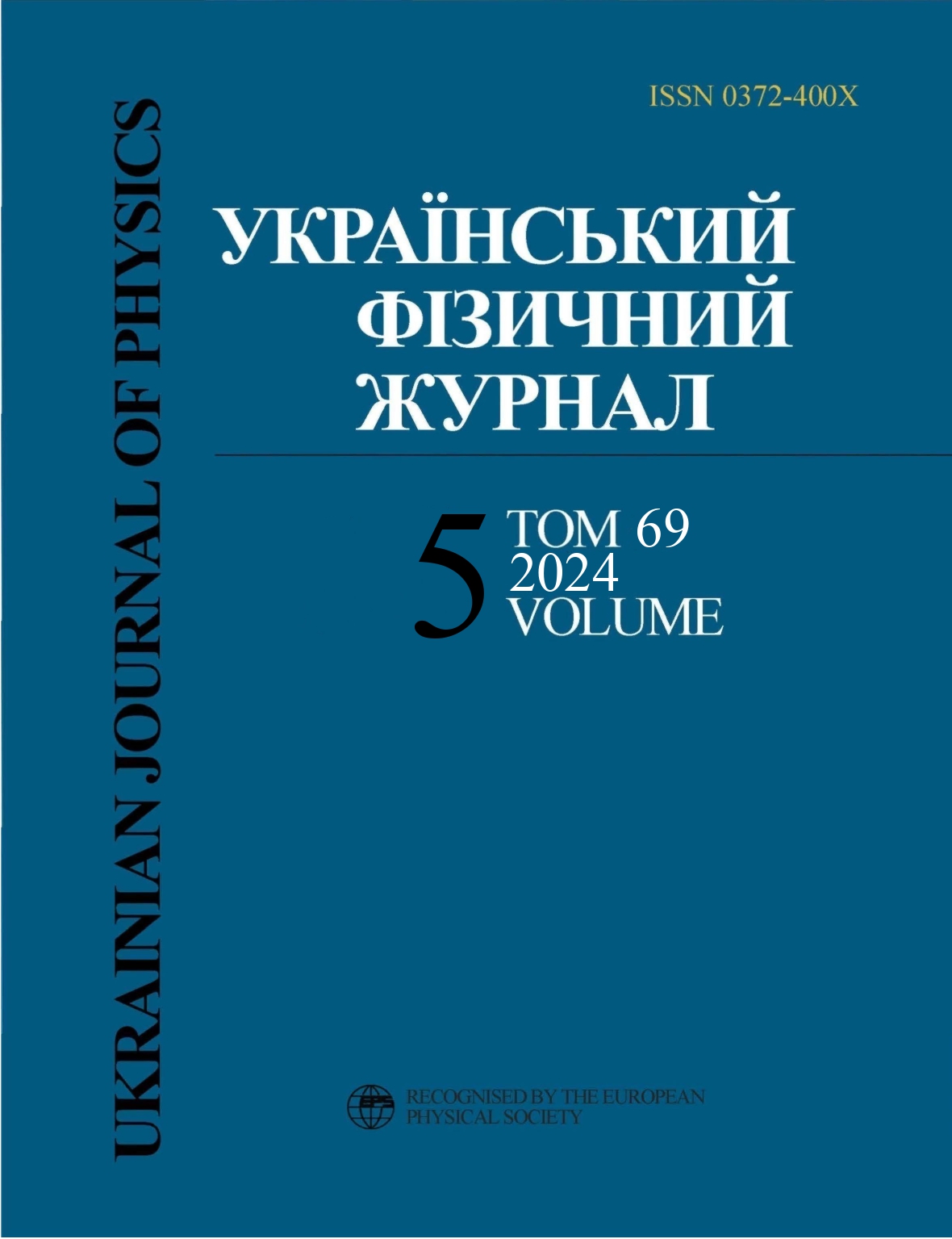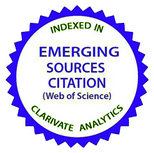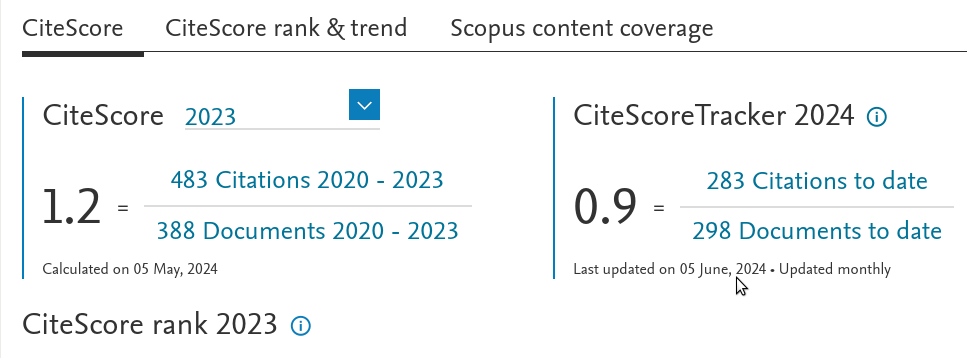Параметри та ефекти магнітного поля і карбонату калію у воді. Застосування
DOI:
https://doi.org/10.15407/ujpe69.5.321Ключові слова:
магнiтне поле, вода, карбонат калiю, скотарствоАнотація
Вода є полярним розчинником. Мiж її молекулами створюються водневi зв’язки, в яких приймають участь атоми водню з однiєї молекули води та кисень з iншої. Постiйне магнiтне поле впливає на формування водневих зв’язкiв. В роботi Ву i Бранта (2020) показано, що електропровiднiсть води у магнiтному полi B = 1,35 Tл змiнюється з 100 до 250 мкСм · см−1. Вiдомо також, що кiлькiсть протонiв у водi зменшується зi зростанням її лужностi. В данiй роботi ми дiяли постiйним магнiтним полем (8 магнiтiв, поле кожного B = 0,3 Tл) на воду об’ємом 1000 л, додавали карбонат калiю (K2CO3) i використовували її як питну воду для овець та кiз.
Посилання
K. Li, H. Zhang, X. Zheng et al. Energies. Hydrogen production by water electrolysis with low power and high efficiency based on premagnetic polarization. Energies. 215, 1878 (2022).
https://doi.org/10.3390/en15051878
J. Dobranski. From mystery to reality: Magnetized water to tackle the challenges of climate change and for cleaner agricultural production. J. Clean. Prod. 425, 139077 (2023).
https://doi.org/10.1016/j.jclepro.2023.139077
M. Sammer, C. Kamp, A.H. Paulitsch-Fuchs et al. Correction: M. Sammer, et al. Strong gradients in weak magnetic fields induce DOLLOP Formation in tap water. Water. 12, 1048 (2020).
https://doi.org/10.3390/w12041048
R. Cai, H. Yang, J. He, W. Zhu. The effects of magnetic fields on water hydrogen bonds. J. Mol. Struct. 938, 15 (2009).
https://doi.org/10.1016/j.molstruc.2009.08.037
I. Ignatov. Water treated with permanent magnetic field. Effects of potassium carbonate. Eur. J. Mol. Biotechnol. 10, 8 (2022).
https://doi.org/10.13187/ejmb.2022.1.8
J. Wang, Sh. An, J. Ren. Regulating microstructure and microscopic properties in salt solutions containing anions and cations by magnetic field. Molecules 29, 543 (2024).
https://doi.org/10.3390/molecules29020543
A. Ch. A. Yap, M. Sh. Lee, J.L. Loo, M.S. Mohd. Electron generation in water induced by magnetic effect and its impact on dissolved oxygen concentration. Sustain. Environ. Res. 31, 7 (2021).
https://doi.org/10.1186/s42834-021-00080-0
T. Wu, J.A. Brant. Magnetic field effects on pH and electrical conductivity: Implications for water and wastewater treatment. Environ. Eng. Sci. 37, 717 (2020).
https://doi.org/10.1089/ees.2020.0182
E. Chibavski, A. Szczes. Magnetic water treatment - a review of the latest approaches. Chemosphere. 203, 54 (2018).
https://doi.org/10.1016/j.chemosphere.2018.03.160
R. Mghaiouini, A. Elmlouky, R.E. Moznine et al. The influence of the electromagnetic field on the electric properties of water. Mediterr. J. Chem. 10, 507 (2020).
https://doi.org/10.13171/mjc10502005181406rm
F.F. Putti, E.F. Vicente, P.P.N. Chaves et al. Effect of magnetic water treatment on the growth, nutritional status, and yield of lettuce plants with irrigation rate. Horticulturae. 9, 503 (2023).
https://doi.org/10.3390/horticulturae9040504
J. Zhang, Q. Wang, K. Wei et al. Magnetic water treatment: An eco-friendly irrigation alternative to alluvial salt stress of brackish water in seed germination and early seedling growth on cotton. Gossypium hirsutum L. Plants. 11, 1297 (2022).
https://doi.org/10.3390/plants11111397
D. Mehandjiev, I. Ignatov, N. Neshev et al. History-dependent hydrogen bonds energy distributions in NaCl aqueous solutions undergoing osmosis and diffusion through a ceramic barrier. J. Chem. Technol. Metall. 58, 340 (2023).
https://doi.org/10.59957/jctm.v58i2.59
I. Ignatov, F. Huether, T.P. Popova et al. Effects of electromagnetic waves on parameters, hydration, and in vitro antimicrobial activity of the Brassica oleracea L. var. italica Plenk and water. Plant Sci. Today. 11 (2024).
https://doi.org/10.14719/pst.2987
Q.Z. Shamsaldain, E.A. Al Rawee. Effect of magnetic water on productive efficiency of Awassi sheep. Iraqi J. Veterinary Sci. 2, 75 (2012).
W. Jia et al. Novel strategy to remove the odor in goat milk: Dynamic discovery magnetic field treatment to reduce the loss of phosphatidylcholine in a flash vacuum from the proteomics perspective. Food Chemistry. 375, 131889 (2022).
https://doi.org/10.1016/j.foodchem.2021.131889
A.L. Alfonso-Aliva et al. Potassium carbonate as a cation source for early-lactation dairy cows fed high-concentrate diets. J. Dairy Sci. 100, 1751 (2017).
https://doi.org/10.3168/jds.2016-11776
K.M. Krause, G.R. Oetzel. Understanding and preventing subacute ruminal acidosis in dairy herbs. A review. Anim. Feed Sci. Technol. 126, 215 (2006).
https://doi.org/10.1016/j.anifeedsci.2005.08.004
R.S. Emery, L.D. Brown. Effect of feeding sodium and Potassium bicarbonate on milk fat, rumen pH, and volatile fatty acid production. J. Dairy Sci. 44, 1899 (1961).
https://doi.org/10.3168/jds.S0022-0302(61)89981-5
Jenkins et al. Addition of potassium carbonate to continuous cultures of mixed ruminal bacteria shifts fatty acids and daily production of biohydrogenation intermediates. J. Dairy Sci. 97, 975 (2014).
https://doi.org/10.3168/jds.2013-7164
S.E. Fraley et al. Effect of variable water intake as mediated by dietary potassium carbonate supple-mentation on rumen dynamics lactating dairy cows. J. Dairy Sci. 98, 3247 (2015).
https://doi.org/10.3168/jds.2014-8557
Ordinance No. 9/2001, Official State Gazette, issue 30, about the quality of water intended for drinking purposes, Bulgaria.
I. Ignatov. Research of the factors of health and longevity of the population in Bulgaria. Bulgarian J. Public Health. 10, 34 (2018).
I. Ignatov, N. Valcheva. Physicochemical, isotopic, spectral, and microbiological analyses of water from Glacier Mappa, Chilean Andes. J. Chil. Chem. Soc. 68, 5802 (2023).
https://doi.org/10.4067/S0717-97072023000105802
I. Ignatov. Review of different types of mountain springs and mineral waters from Bulgaria based on their natural origin and health benefits. Med. Perspekt. 51, 199 (2023).
https://doi.org/10.26641/2307-0404.2023.4.294236
Ordinance No. 44/2006, Veterinary medical requirements for animal breeding sites, Bulgaria.
R. Velichkova, Ts. Petrova, I. Simova. Water resource management in Bulgaria. In: Water Resources Management in Balkan Countries, Springer Water (2020), 295 p.
https://doi.org/10.1007/978-3-030-22468-4_12
M. Vitalli, M. Fontana, A. De Giorgi et al. Natural mineral water and diuresis: A systematic review. Int. J. Environ. Res. Public Health. 20, 5527 (2023).
https://doi.org/10.3390/ijerph20085527
Tz. Vladinova, M. Georgieva. Metamorphism of the westernmost Triassic metasedimentary rocks in the Sakar Unit, Sakar-Strandja Zone, Bulgaria. Geologica Carpathica. 353 (2022).
https://doi.org/10.31577/GeolCarp.73.4.4
L. Kenderov, T. Trichkova. Long-term changes in the ecological conditions of the Iskar River (Danube River basin). Human Impact on Danube Biodiversity in the XXI Century. 393 (2020).
https://doi.org/10.1007/978-3-030-37242-2_19
T.P. Popova, I. Ignatov, N. Valcheva, A.I. Ignatov. Research of zeolite and zeolite water from the Rhodope mountains, Bulgaria. J. Turkish Chem. Soc. Section A: Chemistry. 9, 901 (2022).
https://doi.org/10.18596/jotcsa.1058556
M. Yossifova, D. Dimitorova, E. Tacheva et al. Treatment of waters having different ionic composition and pH with natural zeolite from Bulgaria. Minerals 14, 245 (2024).
https://doi.org/10.3390/min14030245
Sh-Q Su, Sh-Q, M. Hagihala et al. Water-oriented magnetic anisotropy transition. Nat. Commun. 2238 (2021).
B. Plavsic, S. Kobe, B. Orel. Identification of crystallization forms of CaCO3 with FTIR spectroscopy. KZLTET 33, 517 (1999).
##submission.downloads##
Опубліковано
Як цитувати
Номер
Розділ
Ліцензія
Ліцензійний Договір
на використання Твору
м. Київ, Україна
Відповідальний автор та співавтори (надалі іменовані як Автор(и)) статті, яку він (вони) подають до Українського фізичного журналу, (надалі іменована як Твір) з одного боку та Інститут теоретичної фізики імені М.М. Боголюбова НАН України в особі директора (надалі – Видавець) з іншого боку уклали даний Договір про таке:
1. Предмет договору.
Автор(и) надає(ють) Видавцю безоплатно невиключні права на використання Твору (наукового, технічного або іншого характеру) на умовах, визначених цим Договором.
2. Способи використання Твору.
2.1. Автор(и) надає(ють) Видавцю право на використання Твору таким чином:
2.1.1. Використовувати Твір шляхом його видання в Українському фізичному журналі (далі – Видання) мовою оригіналу та в перекладі на англійську (погоджений Автором(ами) і Видавцем примірник Твору, прийнятого до друку, є невід’ємною частиною Ліцензійного договору).
2.1.2. Переробляти, адаптувати або іншим чином змінювати Твір за погодженням з Автором(ами).
2.1.3. Перекладати Твір у випадку, коли Твір викладений іншою мовою, ніж мова, якою передбачена публікація у Виданні.
2.2. Якщо Автор(и) виявить(лять) бажання використовувати Твір в інший спосіб, як то публікувати перекладену версію Твору (окрім випадку, зазначеного в п. 2.1.3 цього Договору); розміщувати повністю або частково в мережі Інтернет; публікувати Твір в інших, у тому числі іноземних, виданнях; включати Твір як складову частину інших збірників, антологій, енциклопедій тощо, то Автор(и) мають отримати на це письмовий дозвіл від Видавця.
3. Територія використання.
Автор(и) надає(ють) Видавцю право на використання Твору способами, зазначеними у п.п. 2.1.1–2.1.3 цього Договору, на території України, а також право на розповсюдження Твору як невід’ємної складової частини Видання на території України та інших країн шляхом передплати, продажу та безоплатної передачі третій стороні.
4. Строк, на який надаються права.
4.1. Договір є чинним з дати підписання та діє протягом усього часу функціонування Видання.
5. Застереження.
5.1. Автор(и) заявляє(ють), що:
– він/вона є автором (співавтором) Твору;
– авторські права на даний Твір не передані іншій стороні;
– даний Твір не був раніше опублікований і не буде опублікований у будь-якому іншому виданні до публікації його Видавцем (див. також п. 2.2);
– Автор(и) не порушив(ли) права інтелектуальної власності інших осіб. Якщо у Творі наведені матеріали інших осіб за виключенням випадків цитування в обсязі, виправданому науковим, інформаційним або критичним характером Твору, використання таких матеріалів здійснене Автором(ами) з дотриманням норм міжнародного законодавства і законодавства України.
6. Реквізити і підписи сторін.
Видавець: Інститут теоретичної фізики імені М.М. Боголюбова НАН України.
Адреса: м. Київ, вул. Метрологічна 14-б.
Автор: Електронний підпис від імені та за погодження всіх співавторів.













